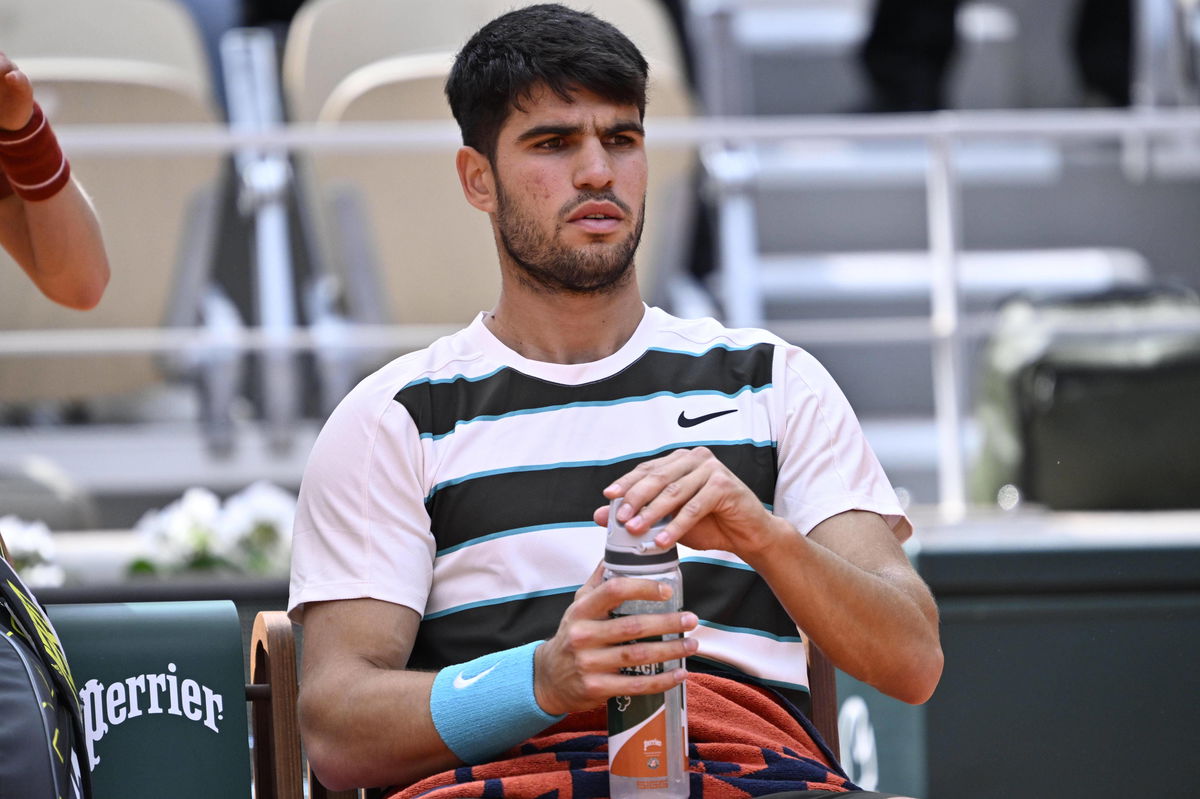
Imago
2025 Roland-Garros – Men s Single Final PARIS, FRANCE – JUNE 8: Jannik Sinner not seen of Italy competes against Carlos Alcaraz of Spain during the Men s Single Final match on the day 15 of French Open tennis tournament on Court Philippe-Chatrier at the Roland-Garros Complex in Paris, France on June 8, 2025. Burak Akbulut / Anadolu Paris France. Editorial use only. Please get in touch for any other usage. PUBLICATIONxNOTxINxTURxUSAxCANxUKxJPNxITAxFRAxAUSxESPxBELxKORxRSAxHKGxNZL Copyright: x2025xAnadoluxBurakxAkbulutx

Imago
2025 Roland-Garros – Men s Single Final PARIS, FRANCE – JUNE 8: Jannik Sinner not seen of Italy competes against Carlos Alcaraz of Spain during the Men s Single Final match on the day 15 of French Open tennis tournament on Court Philippe-Chatrier at the Roland-Garros Complex in Paris, France on June 8, 2025. Burak Akbulut / Anadolu Paris France. Editorial use only. Please get in touch for any other usage. PUBLICATIONxNOTxINxTURxUSAxCANxUKxJPNxITAxFRAxAUSxESPxBELxKORxRSAxHKGxNZL Copyright: x2025xAnadoluxBurakxAkbulutx
The North American summer has turned into a true test of endurance for tennis stars, with both ATP and WTA warriors feeling the scorch. In Ohio, the Cincinnati Open has become a battleground against not just opponents, but the unrelenting heat. On Sunday, Daniil Medvedev, drained and distant, slumped in his courtside chair after a grueling loss to Adam Walton, the sweltering air sapping his strength over two and a half punishing hours. Aryna Sabalenka, after a fierce clash with Emma Raducanu yesterday, quipped with raw humor, “This is how it feels to be old?” And now, Carlos Alcaraz makes an honest admission, as the brutal Cincinnati challenge continues to plague players’ bodies and minds.
Watch What’s Trending Now!
The No. 2 in the PIF ATP Rankings, Carlos Alcaraz, marched past Hamad Medjedovic 6-4, 6-4 in the furnace-like conditions of the ATP Masters 1000 in Ohio. With unshakable composure, he notched his tour-leading 50th win of 2025 and extended his Masters 1000 streak to 13 straight victories, proving once again that heat alone cannot melt his resolve.
Yet, the triumph came under the shadow of mounting heat concerns gripping the tournament. In the WTA draw, Coco Gauff advanced via walkover after Dayana Yastremska withdrew, citing illness from the oppressive weather. Now in the R16, Alcaraz has spoken openly about how he fought through the searing conditions, bending the match to his will.
ADVERTISEMENT
Speaking on the Tennis Channel post-match show, Carlos Alcaraz faced Prakash Amritraj’s question on how he braved the Ohio heat. With a calm yet sharp delivery, he revealed the mental chess behind his survival. “Well, sometimes we are just focused on ourselves. We’re just thinking that we’re struggling a lot with the heat, with the sun, with just feeling bad. And sometimes we forgot about the opponent. The opponent is struggling as well, or even much, much more than you are,” he said, his words carrying the weight of experience.

Imago
250714 — LONDON, July 14, 2025 — Carlos Alcaraz reacts during the men s singles final between Carlos Alcaraz of Spain and Jannik Sinner of Italy at the Wimbledon Tennis Championships in London, Britain, July 13, 2025. SPBRITAIN-LONDON-TENNIS-WIMBLEDON-MEN S SINGLES-FINAL LixYing PUBLICATIONxNOTxINxCHN
Alcaraz then drew strength from his roots. “So I’m trying to think about the opponent as well. And trying to make it a battle really tough. I’m from Murcia, is really hot as well, you know, in summer. So I’m just telling myself that, okay, you have to get used to it, or you’re used to it and trying not to, or not let the sun affect my game or affect me,” he explained, painting a picture of resilience forged in the Spanish heat.
ADVERTISEMENT
His strategy was as much about adaptation as it was about attack. “I’m just trying to keep it going, to try to make the points a little bit shorter. If I can or if I see, you know, the opponent struggling a lot, just making even longer. So it just depends on whether I’m trying not to think about, you know, the sun and just play my game,” he concluded, a warrior’s mindset burning brighter than the Ohio sun.
However, not every player can endure the furnace the way Carlos Alcaraz does. For some, the Cincinnati heat has pushed the body to its breaking point. Arthur Rinderknech collapsed mid-match in sweltering conditions during his third-round battle with Felix Auger-Aliassime.
ADVERTISEMENT
The Frenchman had dropped the opening set 7-6 (7-4) but stood level at 2-2 in the second when he suddenly crumpled near the baseline as Auger-Aliassime prepared to serve. The Canadian and the chair umpire rushed to his aid before medical staff arrived. After nearly two exhausting hours, Rinderknech was given ice packs on his neck and legs during a cooling break, eventually deciding he could continue.
The temperatures, regularly exceeding 30°C, have been testing every ounce of players’ stamina. British No. 2 Cameron Norrie appeared visibly unwell and drenched in sweat during his second-round loss to veteran Roberto Bautista Agut, another casualty of the oppressive heat.
This isn’t an isolated ordeal. Wimbledon this June opened with a record 32.3°C, forcing a pause during Carlos Alcaraz’s five-set first-round clash with Fabio Fognini when a sun-stricken spectator required medical attention. And in January, the Australian Open saw the mercury climb close to 34°C, again pushing players and fans alike to their limits.
ADVERTISEMENT
With matches still grinding on in Cincinnati’s blazing conditions, the heat remains an unyielding opponent. And while the toll on players mounts, Carlos Alcaraz, now in the Round of 16, has once again raised his voice over the relentless demands of the tennis calendar, proving he’s not only fighting for wins but also for the future sustainability of the sport.
Carlos Alcaraz highlights tennis’ growing scheduling concerns
Last year, the ATP set the stage for a seismic shift in men’s tennis. Seven of the nine Masters 1000 events, including Canada and Cincinnati, were stretched into 12-day marathons. The Italian Open, Madrid Open, and Shanghai Masters had already made the leap, and 2025 brought even more change. Dallas, Doha, and Munich climbed from ATP 250 to ATP 500 status, swelling the 500-level calendar from 13 to 16 events. In total, 60 tournaments across 29 countries, a dazzling yet draining global tennis calendar.
ADVERTISEMENT
Carlos Alcaraz, who had raised the alarm on scheduling last year, has once again echoed the same concerns. And this time, he did it from the winner’s circle in Cincinnati after dispatching Hamad Medjedovic.
When asked about the days when body and mind feel far from perfect, Alcaraz didn’t sugarcoat his reality. “I always say that the season is really long, playing a lot of matches, playing a lot of tournaments. More than half of the matches we play, you don’t feel that good. You have to think positive and just play your best tennis possible that day,” he said, his words etched with the weight of the tour’s grind.
Top Stories
26-Year-Old Tennis Journalist Meets Tragic Demise After Battling Brutal Chronic Disease

ESPN Ditches Coco Gauff, Jannik Sinner’s Coaches for Chris Evert After 2 Decades

Coco Gauff Surprises Stefanos Tsitsipas’ Brother After He Calls Her Out at United Cup

17-Year-Old Aussie Shocks 4x WTA Title Winner at Brisbane International

Stefanos Tsitsipas Stuns Injured Taylor Fritz to End Almost Two Year Drought

It was a rare window into the battle beyond the baseline, the fight that isn’t against an opponent, but against fatigue, travel, and time itself. Alcaraz added, “I’m really happy that in really difficult matches I’m able to play my best tennis even though I’m not feeling the right way. I’m just happy and proud about it because it’s something I’m working on.”
ADVERTISEMENT
With players becoming more vocal and the seeds of concern now sprouting, the debate over tennis’s relentless schedule is only growing louder. The question is: how long before the balance tips?
ADVERTISEMENT
ADVERTISEMENT
ADVERTISEMENT

